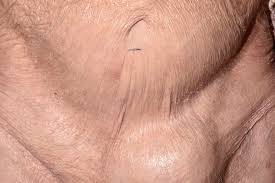Inguinal Hernia
An inguinal hernia occurs when tissue, such as part of the intestine or abdominal fat, protrudes through a weak spot in the abdominal muscles into the inguinal canal. It can affect both males and females but is more common in males.
---
Causes
1. Congenital Weakness:
A failure of the inguinal canal to close properly after birth.
2. Increased Pressure in the Abdomen:
Straining during bowel movements or urination due to constipation or an enlarged prostate.
Chronic coughing (e.g., from smoking or lung disease).
Heavy lifting without proper technique.
3. Aging:
Loss of muscle strength and elasticity with age.
4. Previous Abdominal Surgery:
Can weaken the abdominal wall.
5. Obesity:
Increased weight puts extra pressure on the abdominal muscles.
---
Signs and Symptoms
1. Visible Bulge:
A lump or swelling in the groin area that may disappear when lying down.
2. Pain or Discomfort:
Especially during physical activities, coughing, or bending over.
3. Heaviness or Pressure in the Groin:
A dragging sensation in the lower abdomen.
4. Inguinal Pain:
Pain radiating to the scrotum in males.
5. Strangulated Hernia Symptoms (Emergency):
Severe pain, redness, and tenderness around the hernia.
Nausea, vomiting, and inability to pass gas or stool.
---
Effects
1. Strangulation:
Blood supply to the herniated tissue is cut off, causing tissue death (a surgical emergency).
2. Obstruction:
The intestine becomes blocked, leading to severe complications like vomiting and abdominal pain.
3. Chronic Pain:
Persistent discomfort in the groin area.
4. Infertility in Men:
Rare, but prolonged pressure on the spermatic cord can impair fertility.
---
Solutions
1. Diagnosis:
Physical Examination: A doctor feels for a bulge in the groin while you stand or cough.
Ultrasound or CT Scan: Used for unclear cases or in females.
2. Non-Surgical Management:
Watchful Waiting: For small, asymptomatic hernias.
Hernia Belt or Truss: Provides temporary support but not a long-term solution.
3. Surgical Treatment:
Open Hernia Repair (Herniorrhaphy): The surgeon pushes the hernia back into place and reinforces the muscle wall with stitches or mesh.
Laparoscopic Repair: A minimally invasive procedure using small incisions and a camera.
Advantages: Faster recovery, less pain, and smaller scars.
Suitable for bilateral or recurrent hernias.
4. Lifestyle Adjustments:
Avoid heavy lifting and straining.
Maintain a healthy weight to reduce abdominal pressure.
Manage chronic cough or constipation to prevent worsening.
5. Post-Surgical Care:
Gradually resume activities as advised.
Avoid strenuous activities for several weeks.
---
Prevention
Maintain a healthy weight.
Use proper lifting techniques.
Treat underlying conditions like chronic cough or constipation.
Strengthen abdominal muscles with regular exercise.
---
Prognosis
With timely treatment, most people recover fully from an inguinal hernia. Surgery is highly effective, and recurrence is rare with proper care. Strangulated hernias require immediate medical attention to avoid life-threatening complications. If you notice a groin bulge or experience symptoms, consult a healthcare provider promptly.


